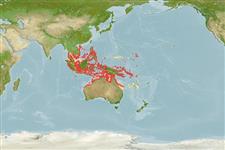Environment: milieu / climate zone / depth range / distribution range
Οικολογία
Θαλασσινό(ά) Υφαλόφιλο(α); μη μεταναστευτικό(ά); εύρος βάθους 0 - 52 m (Ref. 90102), usually 0 - 30 m (Ref. 89707). Tropical; 19°N - 24°S, 97°E - 168°E (Ref. 5222)
Western Pacific: including the Andaman Sea, Gulf of Thailand, Indonesia, Philippines, Papua New Guinea, Great Barrier Reef, Solomon Islands, and New Caledonia.
Μέγεθος / Βάρος / Age
Maturity: Lm ? range ? - ? cm
Max length : 25.0 cm TL αρσενικό/απροσδιόριστο; (Ref. 48635)
Ραχιαίες άκανθες (συνολικά) : 9; Μαλακές ραχιαίες ακτίνες (συνολικά) : 15 - 16; Εδρικές άκανθες: 3; Μαλακές εδρικές ακτίνες: 8.
Adults inhabit shallow waters, usually on silty reefs, midshelf lagoons and backreef areas; feeds on fishes and crustaceans (Ref. 089707). Secretive in corals to about 20 m depth. Juveniles are found under corals with rubble substrate (Ref. 48635).
Life cycle and mating behavior
Γεννητική Ωρίμανση | Αναπαραγωγή | Γεννοβολία | Αβγά | Γονιμότητα | Προνύμφες
Heemstra, P.C. and J.E. Randall, 1993. FAO Species Catalogue. Vol. 16. Groupers of the world (family Serranidae, subfamily Epinephelinae). An annotated and illustrated catalogue of the grouper, rockcod, hind, coral grouper and lyretail species known to date. Rome: FAO. FAO Fish. Synop. 125(16):382 p. (Ref. 5222)
IUCN Red List Status (Ref. 130435: Version 2024-2)
Threat to humans
Harmless
Human uses
αλιεία: περιορισμένης εμπορικότητας
Εργαλεία
Special reports
Download XML
Διαδικτυακές πηγές
Estimates based on models
Preferred temperature (Ref.
123201): 26.6 - 29.1, mean 28.3 °C (based on 1164 cells).
Phylogenetic diversity index (Ref.
82804): PD
50 = 0.5000 [Uniqueness, from 0.5 = low to 2.0 = high].
Bayesian length-weight: a=0.01698 (0.00979 - 0.02945), b=3.10 (2.96 - 3.24), in cm total length, based on LWR estimates for this species & Genus-body shape (Ref.
93245).
Τροφικό Επίπεδο (Ref.
69278): 4.0 ±0.7 se; based on size and trophs of closest relatives
Ελαστικότητα (Ref.
120179): Μεσαίο(α), ελάχιστος χρόνος για διπλασιασμό πληθυσμού 1,4 - 4,4 έτη (Preliminary K or Fecundity.).
Fishing Vulnerability (Ref.
59153): Low vulnerability (15 of 100).
Nutrients (Ref.
124155): Calcium = 64.2 [37.6, 116.7] mg/100g; Iron = 0.625 [0.356, 1.163] mg/100g; Protein = 18.5 [16.7, 20.1] %; Omega3 = 0.179 [0.112, 0.285] g/100g; Selenium = 31.6 [16.9, 53.6] μg/100g; VitaminA = 199 [73, 631] μg/100g; Zinc = 0.874 [0.626, 1.425] mg/100g (wet weight);
